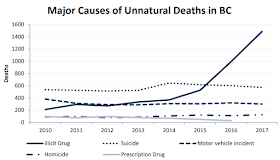One of the things that has been on my mind recently is how to make our roads safer for all people no matter their mode of travel such as walking, cycling, scotering, transiting, or walking.
In 2017, 276 people were killed due to motor vehicle crashes and 21,039 people were injured in British Columbia. To put that into perspective, that is about three low-rise condo buildings of people being killed in our province in 2017, and around the population of White Rock that are being injured due to motor vehicle crashes.
Crashes are one of the top external factors that lead to death in our province along with suicide and illicit drug usage.
 |
| Major causes of unnatural deaths in BC from 2010 to 2017. Source: BC Coroner Services. |
Motor vehicle crashes are also one of the top three reasons why people are hospitalized in our province.
 |
| Number of acute hospitalizations in BC 2016/17. Source: BC Injury Research and Prevention Unit. |
The human cost of crashes is high, and so is the economic cost. In 2018, the cost of crashes was estimated to be $8.4 billion dollars in BC. This is more money that the cost of building SkyTrain to Langley along Fraser Highway, and building the SkyTrain extension from Commercial-Broadway Station along Broadway to Arbutus.
Speed is a significant factor in the amount and severity of injuries due to crashes, and the amount of fatalities. It is not just “speeding” that is a factor, but even the posted speed limits on our roads. Research shows that each 1% increase in speed “would lead to a 2% change in injury accidents, a 3% change in severe injury accidents and a 4% change in fatal accidents.”
The following graph shows the difference speed makes in the survivability of someone who is walking if they are involved in a crash with someone who is driving a motor vehicle.
 |
| A graph of the probability of fatal injury for a pedestrian colliding with a vehicle. Source: EU Mobility and Transport. |
If speeds are below 30km/h, there is a high chance of surviving a crash. At 50km/h, you have a 50/50 chance of surviving. Beyond 60km/h, the likelihood of surviving a crash with a motor vehicle is low.
While these statistics are somber, there are ways that we can improve the safety of our roads. I will be posting about that tomorrow.

No comments:
Post a Comment
All comments are moderated.